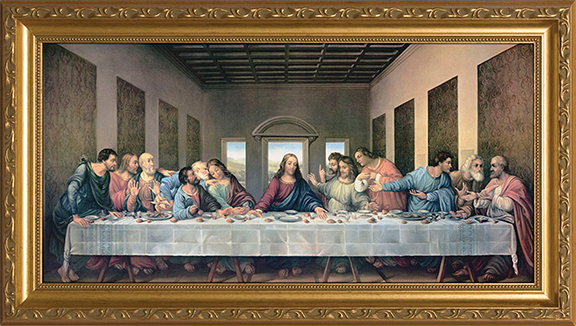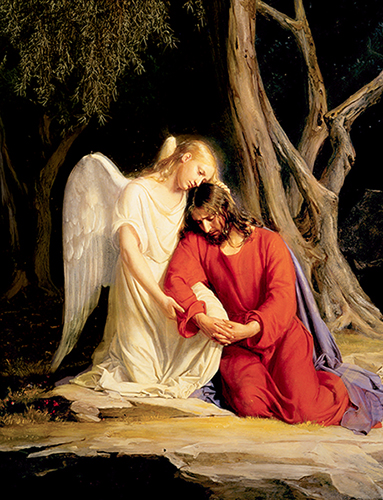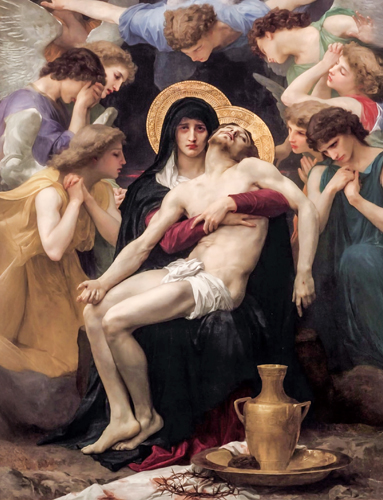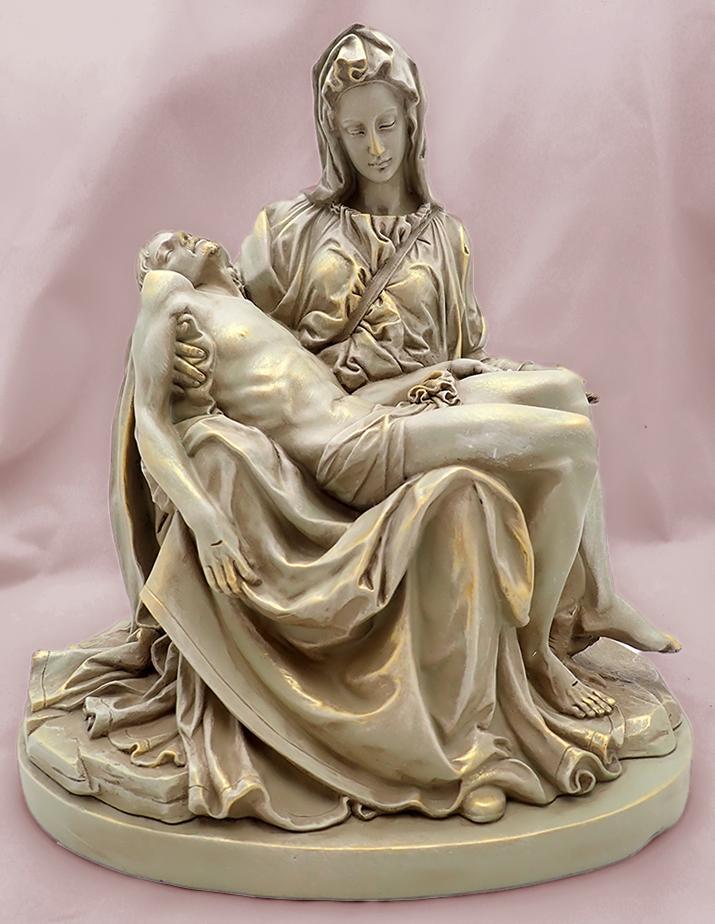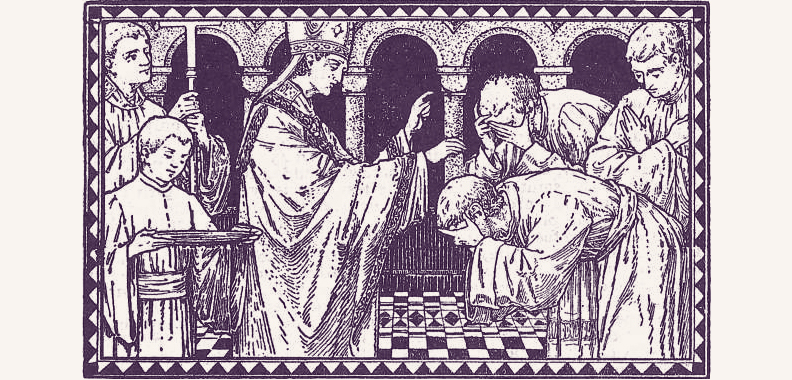
The Power of Ashes
Remember, man, that thou art dust, and unto dust thou shall return.
Dear Friends of Carmel,
Greetings as we look forward to the season of Lent – Spring Cleaning for the soul!
Having recently received the Blessed Candle on the Feast of the Purification (Feb. 2), at the beginning of Lent, we are given another of the great Sacramentals of the Church: Blessed Ashes. Let us remember briefly, what a Sacramental is: “Sacramentals are holy things or actions of which the Church makes use to obtain for us from God, through her intercession, spiritual and temporal favors… Sacramentals obtain favors from God through the prayers of the Church offered for those who make use of them, and through the devotion they inspire” (Baltimore Catechism). Therefore, unlike the Sacraments, which automatically confer grace, the measure of grace and aid we receive from Sacramentals depends 1) upon our devotion, 2) the devotion of the Priest administering them, and 3) the holiness of the Church.
The season of Lent is a season of spiritual warfare for the Church. It is the time when we “go on the offensive,” practicing penance, tackling our vices, and studying our Faith, all for the two-fold purpose of removing the obstacles that stand between us and God, and making up for our sins, thereby growing in divine union and grace. It is a difficult battle, we might say the one great battle of our lives – the battle to save our souls and win the souls of our brethren for Heaven. The Church gives us the great Sacramental of blessed ashes at the beginning of the season to aid us, to prepare our souls, to give us grace in the virtues we most need, humility and compunction, as shown in the prayers of the blessing ceremony:

“Lord, You desire not the death but the repentance of sinners; look down in pity on the frailty of human nature, and in Your goodness deign to bless these ashes which we purpose to place upon our heads to express our humility and to win Your pardon; knowing that we are dust and must return to dust as the price of our perversity, may we deserve to obtain from Your mercy pardon of all of our sins and the reward which You have promised to the penitent.”
– Blessing of Ashes, Ash Wednesday Liturgy
It is therefore in our own best interests to prepare ourselves well to receive Blessed Ashes, so we can make full use of the graces they contain and bestow. We have often and at length written in past newsletters about the season of Lent, but “faith is gained through hearing,” as the Apostle says.
So we decided to upload another sermon on our website, a superb sermon given to our Community on Ash Wednesday many years ago, to assist you during this most important time of the year. Father details the evil of sin, and explains the virtue of penance. He also speaks about ashes, their history in the Church, the blessings imparted on them by the Church, and their power as a Sacramental to aid us in the practice of penance and sorrow for our sins. It is a wonderful explanation to teach and help us prepare well to receive the Ashes on Wednesday with the greatest devotion.
Know of our prayers for you as we begin this great season of growth in divine holiness. May Our Lord share with you the fruits of His Passion and bring us all to a glorious Easter.
Your Carmelite Sisters
Meditation on the Passion
Meditation on the Passion of Christ Our Lord is something that should be at the center of our spiritual lives, and even more so during Lent. St. Alphonsus said “If you wish to advance in your spiritual life, think of the Lord’s sufferings every day, because by thinking of them, it is impossible not to be overwhelmed with love capable of making you forget your own troubles, and strength to overcome with joy the inevitable burdens and trials of life.” St. Paul of the Cross gives similar advice: “Do not pass one day without devoting a half hour, or at least a quarter of an hour, to meditation on the sorrowful Passion of your Savior. Have a continual remembrance of the agonies of your crucified Love, and know that the greatest saints, who now, in heaven, triumph in holy love, arrived at perfection in this way.”
Besides praying the Sorrowful Mysteries of the rosary, and making the Stations of the Cross (a practice that we hope to talk more about in another newsletter), good spiritual reading and meditation books can be invaluable aids to contemplating the holy Passion of Our Lord.
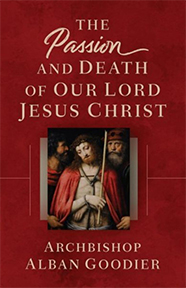
One of the favorites of our Community is the book The Passion and Death of Our Lord Jesus Christ by Archbishop Goodier. Our own copies are well-worn after so many years and highly sought after: never on our library shelves during the season of Lent! The book masterfully intersperses scriptural accounts and narration to bring the Passion of Jesus fully to life. As he guides you through an introspective contemplation of the Gospels, Goodier reveals Jesus’ thoughts, feelings, and actions, and how all reveals the sufferings Jesus felt in His soul.
We will let a few of the other recommended Lenten books on our website speak for themselves, by giving you a small sampling of the meditations and prayers they offer. We hope that some of these brief meditations might facilitate your own reflections and prayers during this great penitential season.
The Last Supper
Excerpt from What Jesus Saw from the Cross by Father Sertillanges:
While He suffers, Jesus has no need to be concerned for the immediate figure of His Church. For this, Heaven has already provided; and even now provisions are being made. The bread of the future is ready; the tongues of fire glow darkly beneath the vaults of the cenacle; the wind is but holding its mighty breath; feet are already waiting to run throughout the earth; hearts are burning to set it on fire. What powers are latent around the Cross! Perhaps the most striking thing about the Passion is the intermingling of two currents of events, the one bearing upon the present and pushing it inexorably to the fatal climax, the other arranging a future and sowing seeds of eternal life in the universe of souls. While the court of Caiaphas and the Sanhedrin men are debating how Christ might be slain, Christ Himself, only a few yards away, devises the means whereby He may live forever on earth. In the very moment He seems to be captured in Judas’ trap, Christ is fully master of His fate. He disposes the manner of His sacrifice and the commemoration that shall be made of it, as well as the part the each one of the faithful shall take in it for all time.
The Agony in the Garden
Excerpt from The Last Hours of Jesus, Fr. Ralph Gorman:
“Not My will, but Thine be done.” The words were simple and few, but they were difficult words to say. They were costly words. They cost Jesus hours of agonizing prayer. They cost Him His life…. Christ was God as well as man. No suffering, interior or exterior, could touch Him unless He permitted it. Whatever He suffered in Gethsemane, He suffered because He Himself, by a deliberate act of His will, allowed Himself to suffer. He opened the floodgates of His soul and gave entry to the torrent of fear and disgust and sorrow that beat upon Him. Nothing could have made Jesus more like us, more lovable, more our Brother, than the agony in the garden. Suffering inflicted by others had at least the appearance of being involuntary. The sufferings of Gethsemane, deep in His soul, could touch Him only because He Himself willed it, and He willed it to show us how human He really is, to give us courage in our fears, to set us an example, to merit for us the grace needed in our interior conflicts. Jesus’ struggle to overcome His natural fear is our model and inspiration in time of interior trials. His agony teaches us better than any words that God does not despise or condemn the weakness of our human nature, that Christian virtue does not consist in callousness or stoical indifference, but in dominating and controlling our human emotions. Fear and sorrow and weariness there must be in every life. Virtue consists not in an effort to bypass or ignore them, but in conquering them, even though the struggle may mean for us, too, a Gethsemane.
Our Sorrowing Mother
Excerpt from On the Passion of Christ, Thomas A. Kempis:
Now, my soul, draw nearer and devoutly kiss Jesus’ ruby-stained wounds. He is lying wounded and dead in His grieving Mother’s lap. No matter how great a sinner you may be, or how acutely the fear of eternal damnation horrifies you, draw near, because it was for you that the Lamb was slaughtered and for you that the Victim, who has taken away the sins of the world, has been offered. So merciful and compassionate is the Lord Jesus, and so holy and sweet is Mary his Mother, that no one who wholeheartedly requests pardon goes away empty-handed or disappointed…
Chosen Mother, hold on your lap your beloved and only Son, who suffered a cruel death for me, and keep Him for a time, while I, on bended knee, adore Him here on earth. I pour out my prayers before Him and kiss His wounds and limbs, disfigured by martyrdom.
Prayer Before a Crucifix
A plenary indulgence to Catholics who recite it on Fridays during Lent
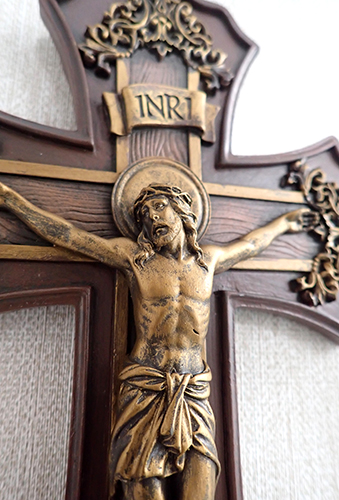
Behold, O kind and most sweet Jesus! I cast myself upon my knees in Your sight, and with the most fervent desire of my soul I pray and beseech You that You would impress upon my heart lively sentiments of faith, hope and charity, true repentance for my sins and a firm purpose of amendment; while with deep affection and grief of soul, I ponder within myself and mentally contemplate Your five most precious wounds, having before my eyes that which David spoke in prophecy of You, O good Jesus: they have pierced My hands and feet, they have numbered all My bones.
New Crucifixes

Understandably, the crucifix has always been at the center of Catholic worship and prayer, so much so, that there has long been a grave obligation for a priest always to have a crucifix on or above the altar when offering Mass. This sign of our salvation is customarily displayed prominently in Catholic homes, in all of the main rooms; it is custom to hang a crucifix over our bed, carry it in our pocket (on the rosary), and hold it in our hands when we pray.
Since the crucifix is such a special and common sacramental in churches and homes, we thought you might like to read the actual Blessing of a Crucifix, from the Roman Ritual (wherever you see the cross sign is where the priest makes the Sign of the Cross over the crucifix. This sign is used frequently in all ritual blessings of the Church):
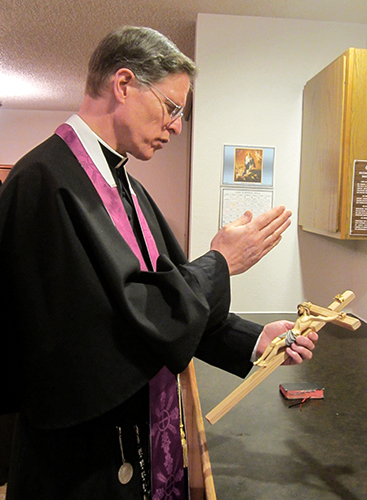
Lord Jesus Christ, bless + this cross by which you snatched the world from Satan’s grasp, and on which you overcame by your suffering the tempter to sin, who rejoiced in the first man’s fall in eating of the forbidden tree. (Here it is sprinkled with holy water.) May this cross be hallowed in the name of the Father, + and of the Son, + and of the Holy + Spirit; and may all who kneel and pray before this cross in honor of our Lord find health in body and soul; through Christ our Lord. Amen.
Wood crucifixes and Pardon crucifixes can also be given the Happy Death Indulgence. If you are unfamiliar with this privilege, you can read about it on our website.
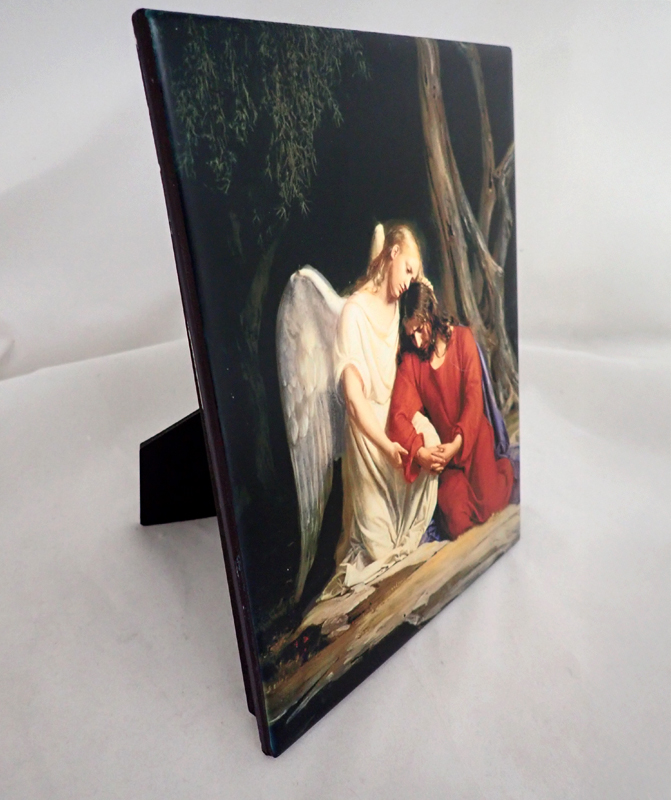
Our wood-carved wall crucifixes from Italy (which have been backordered several months) are available once again, but there is still a three to four week wait time for delivery as they are hand-carved. We decided to expand our offerings to include several more sizes and styles, including standing crucifixes that are perfect for a desk. You might also like to read about the Pardon crucifix and St. Benedict crucifix, if you are unfamiliar with these Sacramentals. We have also added many more new religious prints, statues, and images related to the Passion of Christ to our website, which you have seen pictured throughout this newsletter. We hope that they will be a source of blessing and devotion for you.
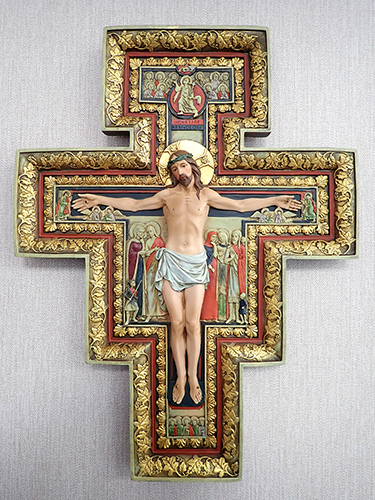
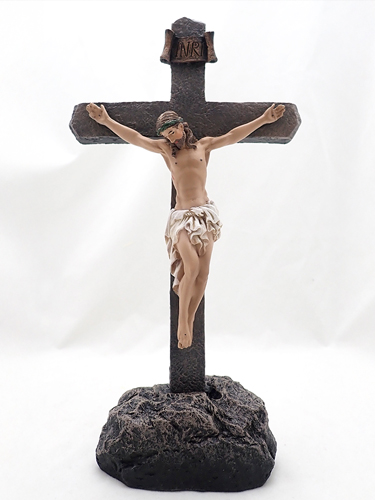
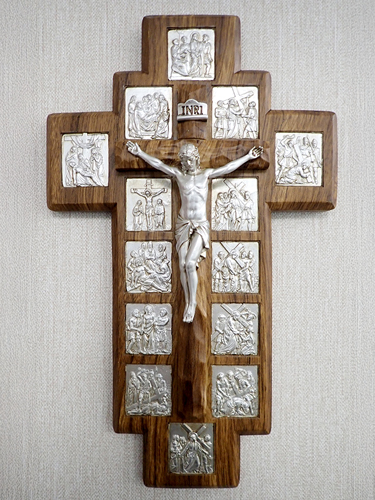
The Importance of Blessing Sacramentals
While considering Ash Wednesday and the Sacramental of Ashes, it is good to keep in mind a very important point regarding Sacramentals. On our website, we offer many items – rosaries, statues, medals, scapulars, etc. All of these items can be great sources of grace and aid from Heaven. Almost all of them have a history of miraculous healings, wondrous conversions, and innumerable other graces and favors from God. However, as we mentioned above, these things do not have power until they become Sacramentals – that is, become sacred. They only become Sacramentals when they receive the blessing of the Church. It is this blessing, with its prayers and often some kind of ceremony, that imparts the power they then possess – the power to be God’s own instruments to convey His grace.
We might use as an example our own Holy Mother St. Teresa of Avila, who experienced her own deeper conversion through an image of the Ecce Homo. She describes the experience in her autobiography:

“It happened that, entering the oratory one day, I saw an image which had been procured for a certain festival that was observed in the house, and had been taken there, to be kept for that purpose. It represented Christ sorely wounded, and so conductive was it to devotion, that when I looked at it, I was deeply moved to see Him thus. So well did it picture what He suffered for us, so great was my distress when I thought how ill I had repaid Him for those wounds, that I felt as if my heart were breaking, and I threw myself down beside Him, shedding floods of tears, and begging Him to give me strength, once and for all, so that I would not rise from that spot, until He had granted me what I was beseeching of Him. And I felt sure that this did me good, for, from that time onward, I began to improve in prayer and virtue.”
The grace did not come from the image itself, but through it, God chose to give this great grace to His future Saint by moving her to a compunction and resolution of spirit she had not until then been able to find on her own. She also describes her use of blessed Holy Water and the refreshment of soul she derived from its use because of the power of the Church’s blessing:
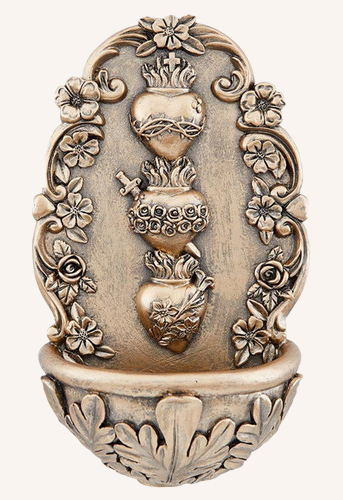
“From long experience I have learned that there is nothing like holy water to put devils to flight and prevent them from coming back again. They also flee from the Cross, but return; so holy water must have great virtue. For my own part, whenever I take it, my soul feels a particular and most notable consolation. In fact, it is quite usual for me to be conscious of a refreshment which I cannot possibly describe, resembling an inward joy which comforts my whole soul. This is not fancy, or something which has happened to me only once. It has happened again and again, and I have observed it most attentively. It is let us say, as if someone very hot and thirsty were to drink from a jug of cold water: he would feel the refreshment throughout his body. I often reflect on the great importance of everything ordained by the Church and it makes me very happy to find that those words of the Church are so powerful that they impart their power to the water and make it so very different from water which has not been blessed.”
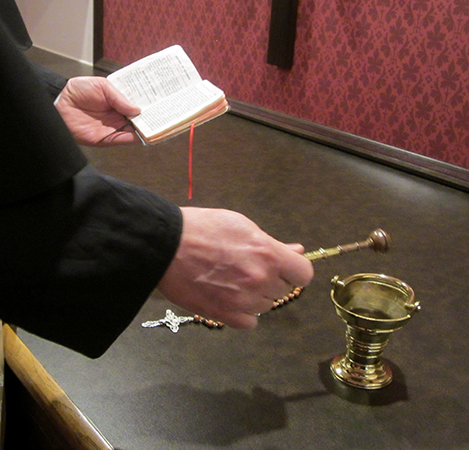
It is therefore very important to have your spiritual items blessed! The blessing of the priest removes that item (a medal, statue, etc.) from the realm of worldly things and places it in the realm of the Divine. The object becomes, in a sense, God’s property, consecrated to Him, and He often chooses to use them as channels of grace. We speak often in our newsletters about the different sacramental graces attributed to different Sacramentals – the exorcisms against the devil on the St. Benedict medal, the conversions wrought through the Miraculous Medal, etc. – but if the object is not blessed, none of those benefits accompany it.
We are always happy to have items from our website blessed upon request before we ship. But it is never too late to have something blessed! If you have a statue, rosary, or medal that you know was not blessed, do not hesitate to take it to your priest. His blessing will help you gain the greatest benefits from these great spiritual gifts the Church has given us in our spiritual warfare.
New Ecce Homo Relic Badge

The Sisters so loved the Ecce Homo pictured above when they saw our new printed plaques, that we designed a new Passion badge with this beautiful image as well. On the back is the plea of Our Lord “I looked for one to comfort me.” The new badge is touched to all of our relics connected to the Passion: The True Cross, a piece of the nail, a rock from Mt. Calvary, the rock of agony in Gethsemane, to the Holy Sepulcher (Our Lord’s Tomb). It is available in both deep burgundy (in honor of the Precious Blood) and black (the color of grief and mourning).
New Candles
One of our favorites of the new incense scents on our website is the Holy Cross scent, a combination of Lavender, Cypress and Sandalwood. Biblically, sandalwood was another of the “spices” used by the Jews in burial. The cypress tree is one of the tallest trees to be found in the Holy Land, so for the Jews it was a symbol of striving towards Heaven and eternal life. This was why Solomon used cypress to build the first temple. Lavender is a floral scent, known well for its calming effects. We named this combination of scents after the Holy Cross, since the Cross is a symbol of death (sandalwood) transformed by Christ’s sacrifice into a symbol of eternal life (cypress). Its strong wood undertones are sweetened by the lavender: “Sweet the wood, sweet the nails, sweet the load that hangs thereon” (from Good Friday liturgy). It was through Christ’s Cross that we are given the promise of peace and eternal happiness in Heaven.

Our Prioress had the idea of also making this scent available in the form of a candle as well, and so we asked the young artisan who makes both of these products if she would be willing to do so. The new scented candle is available in pillar form.
Sacred Music
Prayers also are Sacramentals. Though not physical objects, every liturgical prayer and blessing is a Sacramental – just as stated above: “…holy things or actions of which the Church makes use to obtain for us from God, through her intercession, spiritual and temporal favors…” A saying of St. Augustine was, “He who sings prays twice.” Liturgical music, therefore, is truly sacred, proclaiming, beseeching the glory and grace of God through divine worship. Just listening to liturgical music is reflective and prayerful!

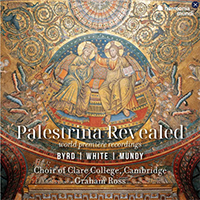

We have often spoken of the Gregorian chant, which is the supreme music for the holy liturgy. But polyphony, also, is favored for use at Holy Mass. Several papal encyclicals (Pope St. Pius X, Pius XI, and Pius XII) present principles and guidelines for the proper use of music for divine worship. Above all, they command and advocate beauty, reverence, purity, simplicity, prayerfulness. This year, the Catholic world and the music world celebrate the 500th anniversary of the birth of the devout Catholic Italian composer, Giovanni Pierluigi da Palestrina (February, 1525-February, 1594). Palestrina is considered the greatest composer of liturgical music of all time, the master of polyphony. Two new choral CDs commemorate this anniversary: Palestrina Revealed and Golden Renaissance: Palestrina. Two more beautiful recordings for this holy season is O Vos Omnes: Music for Lent and Holy Week and Gregorian Chant – Passiontide from the Monastery of Solesmes. Anyone who has had the joy of singing sacred polyphony in a choir treasures the experience – especially Palestrina.

This gifted young man came under the influence of St. Philip Neri in his youth, early in his music career. As the saint’s penitent and spiritual disciple, he gained that insight into the spirit of the liturgy, which enabled him to set it forth in polyphonic music as it had never before been done. It was his spiritual formation even more than his artistic maturity, which fitted him for the providential part he played in the reform of church music at the time of the Council of Trent. St. Charles Borromeo was another of his guides and patrons.
One historian wrote of him: “Palestrina’s significance lies not so much in his unprecedented gifts of mind and heart, his creative and constructive powers, as in the fact that he made them the medium for the expression in tones of the state of his own soul which, trained and formed by St. Philip, was attuned to and felt with the Church.”
Lenten Meditation
“Behold, now is the acceptable time…” With great solicitude has this divine means been given us, so that these forty days of reflection may assist us to restore the purity of our souls, and so that during them we may by good works make satisfaction for our past sins, and by devout mortification purge ourselves of them…For this is also a time for gentleness and patience, a time of peace and serenity, in which having put away all stains of evil-doing we strive after steadfastness in what is good.
Now is the time when generous Christian souls forgive past offenses, pay no heed to insults and wipe out memory of past injuries. Now let the Christian soul exercise itself in the armor of justice, on the right hand and on the left, so that amid honor and dishonor, evil report and good, the praise of men will not make proud the virtue that is well rooted, the conscience that has peace, nor dishonor cast it down. The moderation of those who worship God is not melancholy, but blameless.
– Pope St. Leo the Great

